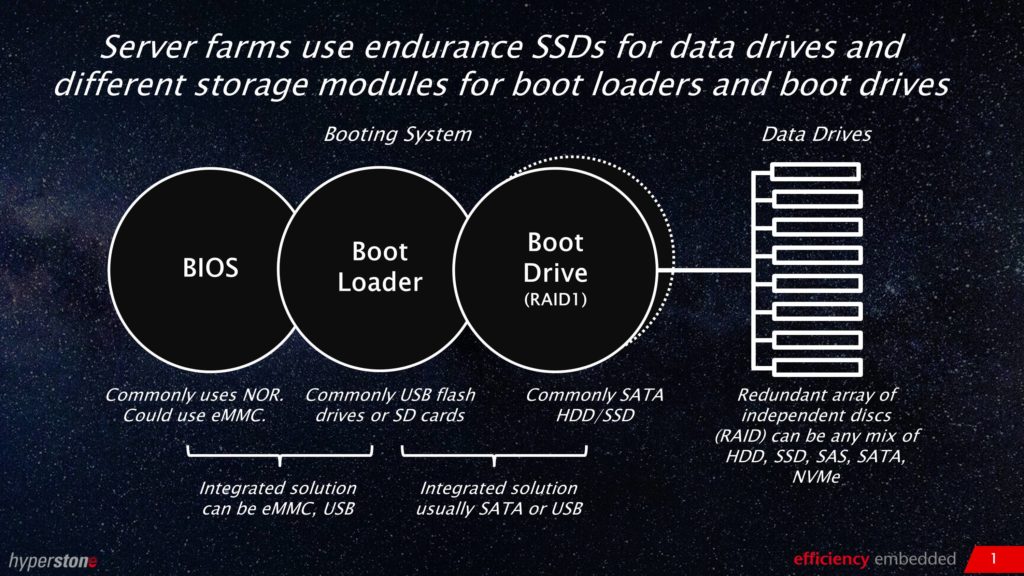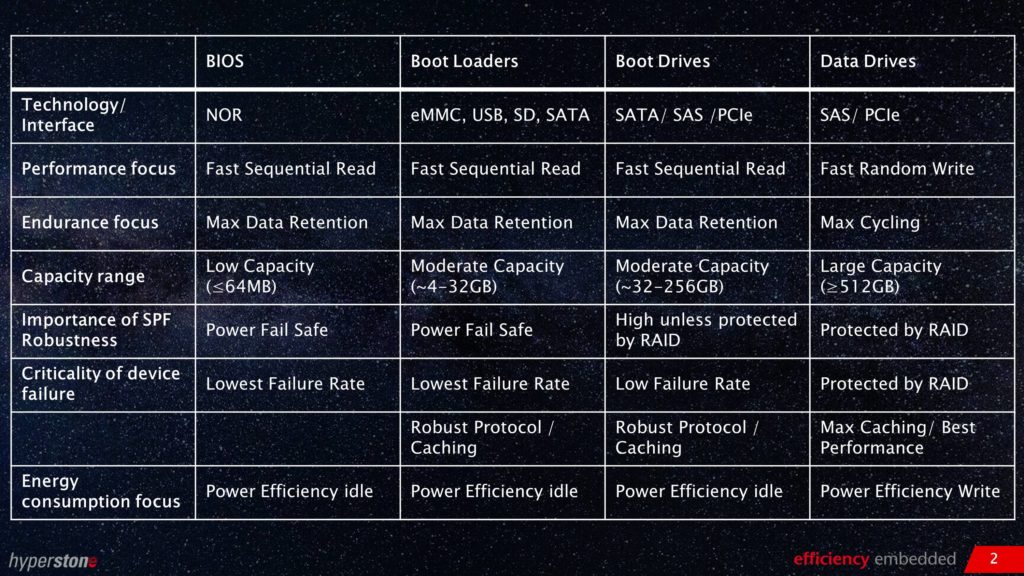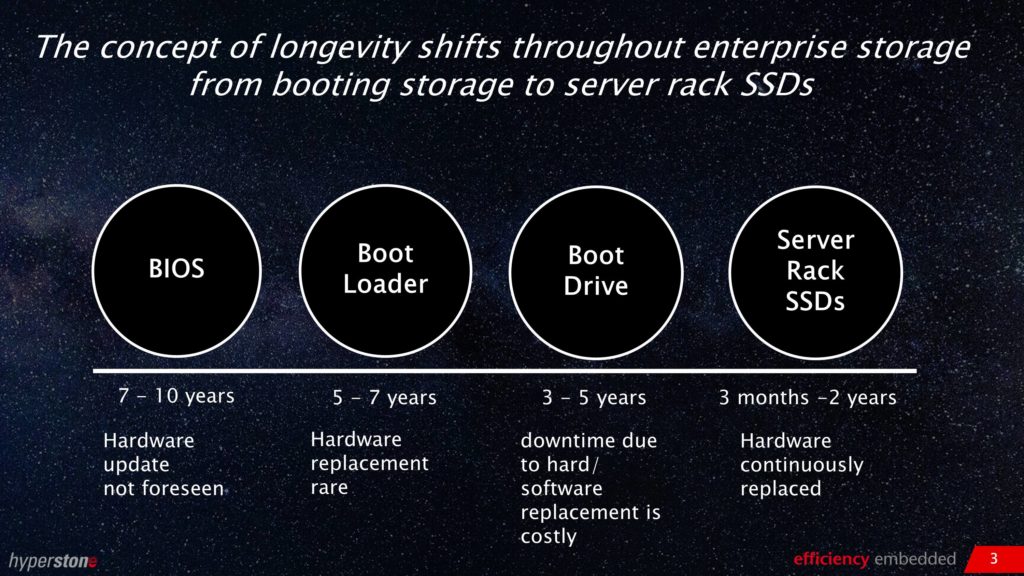by Steffen Allert, Hyperstone
Storage modules are an integral part of consumer, industrial, and enterprise systems. The unique work-load and challenges of these markets dictate the design and components making up the systems. It is commonly understood that the storage systems designed for the enterprise sector are heavily focused on achieving significant endurance rates. The rack server SSDs in server farms are designed to target speed, low latency, and maximum drive writes per day. Their performance should be second to none. However, while we associate data centers with high-performance SSDs, it’s important to acknowledge that there is a second type of storage necessary to make the server work. Often overlooked, boot drives are vital to the success of these data cities.
Drives for operating Systems and boot loaders make up approximately 2% of the total number of drives for enterprise storage solutions. Boot drives are designed to ensure the safe start and shut down of servers in all conditions. Their use case is unique because they don’t boot often, but when they do, it must be efficient and reliable. Their design requirements are entirely different from that of rack server SSDs which form the mass storage part of the server farms. Sometimes Boot Loaders are separated from the actual OS and often come in the form of USB flash drives or SD cards. Those need to carry out reliable processes to ensure safe and secure booting, authenticate usage patterns, and be power fail robust under all circumstances. In other cases, Boot SSDs are used to hold the boot loader as well as the OS. Frequently those drives are protected by a RAID1.
The flash memory controller and FTL ensures that a system is perfectly optimized for its use-case and unique workload. Furthermore, the controller requirements differ significantly between those used for rack server SSDs and booting systems.
Demands of boot-storage and enterprise data drives
Server farms are known for their enterprise endurance SSDs. However, their booting systems comprise of more modules, including BIOS (Basic IO System), boot loaders and boot drives. These all have a unique set of requirements. Since the boot system acts as the gatekeeper for servers, these drives should be as reliable and secure as possible and not compromise to power failure or data retention issues. As the amount and value of processed data increases, so too, should the quality and reliability of the booting medium. The best system is only as good as the weakest part of the chain.
BIOS (Basic Input Output System) have until now commonly been stored on NOR and serve to configure the basic start-up functions, configure the system and the booting sequence. NOR seems suitable because of the relatively smaller capacity requirements, NOR’s reliability and good read/write speeds for small updates. However, alternative embedded storage media such as eMMC, eUSB or eSATA could potentially be a reliable replacement for NOR unifying elements of the BIOS, boot loader, and basic OS. Boot loaders are commonly stored in a NAND flash-based USB drives and SD cards. The advantage of SD cards and USB flash drives for boot loaders is that not only are they capable of booting quickly and securely, but they offer the necessary storage capacity that NOR does not.
Boot drives storing the OS require larger storage capacity. While it is not uncommon for the boot loader and drive to operate off two different mediums, certain manufacturers have started coupling the two processes in a single more reliable solution. NAND based solutions are already widely used for boot loaders and boot drives. However, what is often overlooked are the capabilities of the flash memory controller and the role it can play in managing and optimizing the booting system. Reliable start-up procedures are essential for the operation of data centers. The flash memory media and the quality and performance specification of the controller should be a major discussion regarding the architecture of such systems.
Importance of flash controller in NAND-based booting storage
When it comes to booting with NAND flash-based modules, the chosen flash memory controller is highly crucial as it dictates the reliability and speed of the entire process. A RAID can be a solution to achieve reliability. An industrial-grade flash memory controller and system can add value and reliability and can be perfectly tuned to optimize the booting process. The controllers can enable secure authentication processes and anti-tempering measures making sure the OS has not been compromised. The controller can enable several security features such as secure-boot, redundant firmware, authorized in-place firmware update, device binding, anti-cloning, write protection, confidentiality, and data integrity checks.
While, fast-booting, authentication, and security are of utmost importance in boot drives, it could be argued that the most important requirement is power fail safety, under all conditions. Often a RAID1 and mirror boot drive ensures a level of reliability. However, the unexpected shutting down of a system can still have serious ramifications on a drive that is unprepared or not designed to handle such a process. Data can be lost, and in a worst-case scenario, the backbone of the servers, the OS can be compromised. Last not least, a failing drive needs replacing adding to the service cost. Since booting systems manage the operation of many other drives, so much is hinged on their reliability, and they should be as robust as possible. Flash memory controllers are like brains, each with different IQ levels. This means that compromised power can be handled very differently by one controller vendor compared to another. Booting demands best-in-class power fail management to ensure that servers aren’t jeopardized in the event of a black-out.
Swap-space and demand for reliable foundations
Often overlooked, swap-space is an area on servers that demand reliable foundations. Swap-space demands a part of the storage and usually a portion of the boot drive. This space is set aside for the OS to use as overspill when RAM demand is high.
Since servers don’t reboot all too frequently, typically most of the read/ write usage on the boot drive is performed by memory swap. This means increasing speed can give a performance boost too to a heavily loaded server. Since the enterprise sector has a growing focus on performance, RAM is in high demand in servers. This, in turn, leaves swap-space a necessary and growing part of servers that needs to be considered properly. As well as fulfilling the requirements for fast-booting, authentication, security, and power fail safety, memory swap in servers demand that boot drives are designed with reliability in mind.
Longevity should be discussed more for enterprise storage
Endurance but also Longevity are major topics in the industrial sector where in some cases storage systems must perform for over a decade, and compatible replacement drives must be available of an extended period also for legacy interfaces. Boot drives outlive data drives, and for some server systems, endurance and longevity are also considered to keep re-qualification and software porting cost to a minimum. Sourcing industrial-grade flash memory systems allows necessary safe and secure booting processes, authentication and power fail robustness. It also ensures that systems last longer and are more stable.
Overall enterprise is well known for its performance demands, but the reliability requirements for its booting systems are often overlooked. Boot loaders are a vital part of enterprise storage and must be designed to conduct the safe start and shut down of servers. They must ensure secure booting and not compromise OS and data to unexpected power failures. The key component in storage systems, which ensures a storage module is perfectly optimized for booting storage is the flash memory controller. Flash memory controllers are different from vendor to vendor. While certain manufacturers design controllers perfect for consumer storage, Hyperstone specializes in industrial-grade flash memory controllers, ideal for booting storage in enterprise server houses.
 Steffen Allert is heading the European Sales organization of Hyperstone. His responsibilities covers all sales-related activities for the EMEA region. Steffen has been involved with the flash industry for over 10 years. Before joining Hyperstone he worked for Daimler Benz Aerospace (now Airbus) and Siemens. Steffen holds an MS in Electronics from the Technical University Darmstadt, Germany and a BBA from GSBA Zurich.
Steffen Allert is heading the European Sales organization of Hyperstone. His responsibilities covers all sales-related activities for the EMEA region. Steffen has been involved with the flash industry for over 10 years. Before joining Hyperstone he worked for Daimler Benz Aerospace (now Airbus) and Siemens. Steffen holds an MS in Electronics from the Technical University Darmstadt, Germany and a BBA from GSBA Zurich.





Leave a Reply
You must be logged in to post a comment.